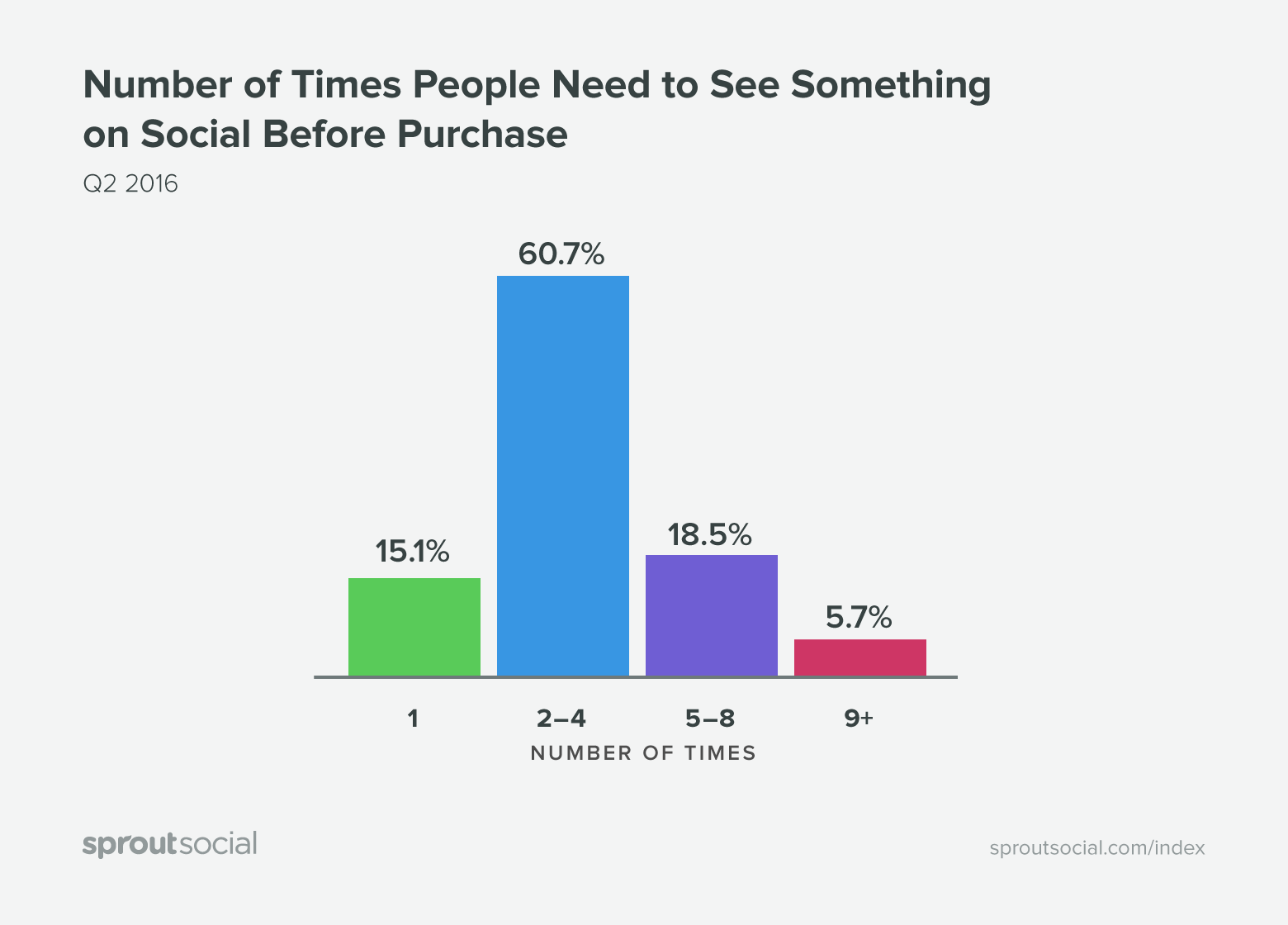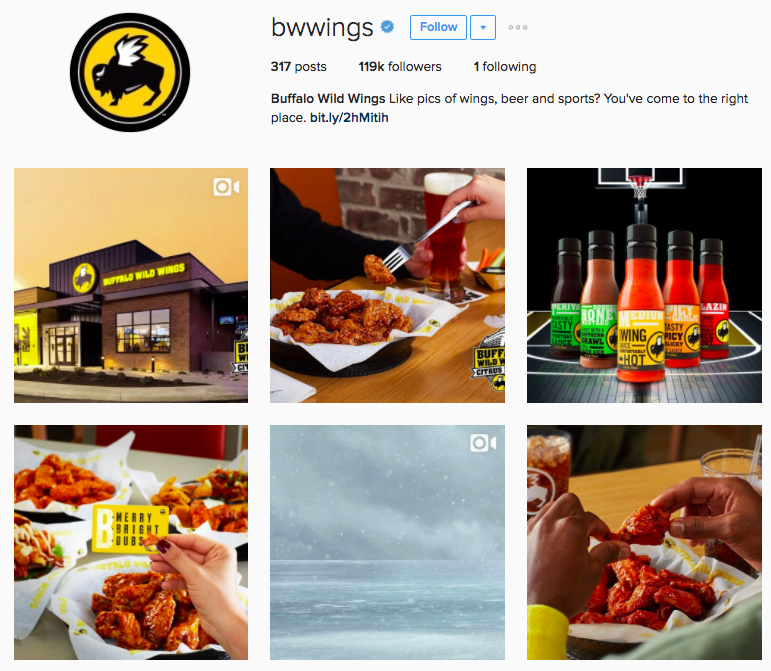The complete guide to social media for restaurants & bars

With more than 371 million posts tagged #food and 41 million with #drinks, food and beverage photos are easily some of the most popular types of content on Instagram. It’s very likely that your customers are posting with or without your interaction.
When 88% of people are influenced by reviews and online comments, having an intentional digital strategy is important to your restaurant or bar.
In this guide to social media for restaurants and bars, we’ll discuss:
- What you’re missing out on if you’re not on social media
- Setting up your profiles for success
- Creating relevant posts
- Using location-based advertising
- Next-level marketing strategies
- Analyzing all of your work
Can Restaurants Afford to Not Be on Social Media?
According to our Q3 2016 Sprout Social Index, 75% of people purchased a product because they saw it on social media. Of that percentage, 60.7% need to see a post 2-4 times from the company before making a purchase.

If you’re not visibly active on social media, then you’re missing out on a large customer base.
Fill out All of Your Profiles
If you’re just getting started on your restaurant social media accounts, make sure pertinent information like your hours and contact information can be easily accessed on your profile. The less clicks it takes to find out about your bar, the better.
Milwaukee-based Camp Bar has multiple locations that they squeeze into their Twitter bio.

Multi-location Buffalo Wild Wings uses the limited Instagram bio space to speak directly to their customer. Wings are part of their name and a big customer draw. It makes sense to have the meal featured prominently in their bio and in their photos.

Facebook Pages offer an easy way to input your information, including opening hours, address, messaging options and popular times to visit. The Publican’s Facebook Page showcases its busiest hours. This can be incredibly helpful for those who are unfamiliar with the restaurant.

There are many other attributes of Facebook Pages that you should take advantage of:
- Add a Book Now button if you accept reservations
- Upload your menu
- Add cuisine type
- Add services like “Good for Kids,” “Good for Groups” and “Take Out”
- Allow Reviews (and remember to respond to them)
If you need more information on how to set up your Facebook Business Page, check out our complete guide and walkthrough.
Set up Multiple Locations on Facebook
If you have multiple locations, Facebook makes it easy for you to add all the addresses. While it may be a pain to set up in the beginning, the benefit is that the closest locations will pop up for your customers. If you have numerous locations, consider uploading a spreadsheet to Facebook instead. You can use this to your advantage later by creating location-based Facebook ads.
Think of the main Page as the umbrella Page, as demonstrated by the Revelator Coffee Page below.

Each location is able to have its own subpage linked to the main one like this Birmingham location. Depending on your social media marketing strategy, you can have the individual locations handle their own posting.
This can benefit you in a few ways:
- You can reshare from location Pages to the main Page. This means less time is needed to curate branded content.
- It’s easier to promote location-specific menu specials.
- Customers can post location-specific reviews. It can be a pain to navigate negative customer feedback. If locations are readily available for the customer, then you won’t need to decipher which bar had slower service than normal.
While establishing location-based Facebook Pages can have its advantages, there are downsides to managing multiple Pages.
- You have more Pages to pay attention to. Luckily, our Smart Inbox helps you manage messages all in one location.
- More Pages mean a greater likelihood that posts veer off-brand. You can prevent this from happening by establishing a brand voice and educating community managers about it.

Create Relevant Posts
Engagement vs. Promotional Posts
In the same Sprout Index, research discovered the most annoying action brands make on social media is too many promotional posts. What do promotional posts look like? They’re the in-your-face marketing that you encounter on a daily basis.

Most promotional posts talk about discounts or a specific product. It’s the equivalent of the party guest who only talks about themselves. But if that person began conversations with questions, listened to other guests and made new connections, then you wouldn’t mind a bit of boasting every now and then.
Promotional posts don’t need to be blatant marketing. Incorporate action shots or product placement in a way that is visually attractive to your customers. The best photos or videos can get your customer momentarily imagining themselves at your business.
Approach social media like you would a group of strangers at a party. Sprinkle tidbits about yourself while mostly engaging with other people. Engagement posts focus the conversation on your customers.
Here are a few ideas to begin a conversation:
- Ask a question
- Solicit customer opinions on new products
- Incorporate user-generated content into your social media strategy
What are you brewing this fine morning?
— Blue Bottle Coffee (@bluebottleroast) July 23, 2016
Post at Optimal Times for Your Restaurant
It’s important to know the best times to post to social media, but make sure you understand your core audience first. Take time to analyze your current stores’ traffic to know when to best reach your customers.

For example, if your bar doesn’t open until 8 p.m., then posting about mixed drinks at 9 a.m. won’t work very well. This is why it’s important to work with time ranges instead one specific set time. See our data on restaurant brands’ best times to post on Instagram.
Alternatively, you can post content that’s easily digested (no pun intended) at any point of the day. Examples of this type of content include staff features, interior and exterior shots, general food items (excluding alcoholic drinks) and behind-the-scenes company updates.
Yes, we are ready. @Seahawks pic.twitter.com/W883fis5Dp
— Top Pot Doughnuts (@Toppot) January 2, 2017
Any favorite songs come to mind? 🎶 (💭 : @akaMikeG) pic.twitter.com/sq5RHt1Y1c
— Five Guys (@FiveGuys) December 28, 2016
Because social network timelines are more algorithmic, we highly recommend a social media advertising strategy that pairs with your posted content. You can promote posts at a designated hour to ensure that your customers see the burger special before dinnertime.
What’s the point of posting a mouthwatering dinner photo if your customers don’t see it until the next morning?
Take Advantage of Location-Based Advertising
Location-based advertising allows you to control when people see your ads, oftentimes within a certain radius. On Facebook, you have the ability to target from specific business locations. When a customer walks by a location and happens to be browsing Facebook, they’ll be served up a Facebook Ad.

According to NinthDecimal’s Mobile Audience Insights Report,
- Retail mobile ads performed best when served within 2-5 miles of a store—24% better than the average CTR.
- Store visits increased 80% within the 1st day a mobile ad was served compared to average store visits.
Take Your Restaurant Social Media Pages to the Next Level
If you feel like you’ve got your digital strategy down but still need a little spunk in your posts, consider one of these advanced marketing strategies:
1. Pair up With Another Chef or Bartender for a Collaborative Meal
Collaborations work well in person and in digital form. Begin by picking a restaurant or bar that you would enjoy working with.
2. Feature a Social Media Influencer
Take advantage of social media influencers by offering exclusive meals or curated experiences. One way to feature a takeover is to invite an influencer to showcase nearby experiences they enjoy. For example, if your restaurant is based in Denver, they can post about your food and other local attractions they enjoy.
Another way to work with influencers is to create a collaborative menu item or event. This can be especially useful for ingredient-oriented brands. For example, a BBQ sauce brand could work with someone to create a special recipe that becomes published on an influencer’s blog.
3. Go Live
Stream parties, game-day events and talk about new promotions on live video. This is also a great way to go behind the scenes on your bar. Set up a live Q&A with your chef or feature a mixologist who can show you how to mix a drink at home.
4. Create Spaces Specifically for Social Media
Mr. Holmes Bakehouse in San Francisco is a very small space. However, lines for their cruffin are out the door every morning and the bakery has become a destination spot for Instagrammers.
From the neon sign to the tiled words “Holmes Sweet Home,” customers flock to the store just to prove they were there.
You can take a similar approach with uniquely tiled floors, wallpaper or other signage. Highlighting what makes you unique should be clear in your social promotion.
Analyze Your Social Media Strategy for Your Restaurant
All of the effort you place into creating content, maintaining your community and responding to reviews mean little without data to back it all up.
Sprout Social’s Group Reports allow you to connect multiple Facebook Pages, Instagram profiles and Twitter accounts to give you a high-level report on your company. This report can keep track of all of your locations without someone manually inputting data into a spreadsheet.

To get you started, here are some statistics you can track:
- Branded hashtag use
- Facebook check-ins
- Geo-tagged photos or posts
The food and drink industry has an advantage on social media. The perfect slice of pizza or freshly baked bread being sliced open can cause a visceral, mouth-watering reaction in the viewer. The content is waiting for you in your restaurant.
https://instagram.com/p/BOFI3fvgXCe/

Share